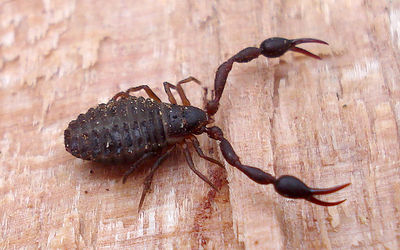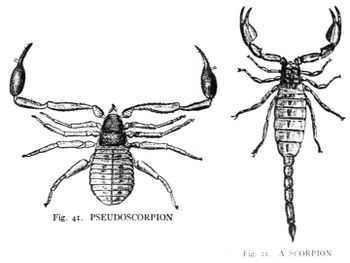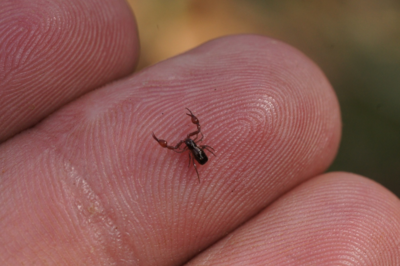Pseudoscorpions: Difference between revisions
| Line 15: | Line 15: | ||
== Characteristics and Morphology == | == Characteristics and Morphology == | ||
[[File:scorp.jpg|350px|right|thumb|[7] Drawings of a pseudoscorpion and a scorpion from JH Comstock’s book. Note that the scale is different for each drawing.]]] Pseudoscorpions superficially resemble true scorpions, though, they lack the elongated metasoma (tail) | [[File:scorp.jpg|350px|right|thumb|[7] Drawings of a pseudoscorpion and a scorpion from JH Comstock’s book. Note that the scale is different for each drawing.]]] Pseudoscorpions superficially resemble true scorpions, though, they lack the elongated metasoma (tail) and stinger at the end of their abdomens.[3] Another crucial difference between the two types of arachnids is size. A common house pseudoscorpion, such as the Chelifer cancroides, will usually only grow between three and four millimeters. While the largest known pseudoscorpion species, the Garypus titanius, can grow up to around 12mm (0.5 in). Overall, pseudoscorpions species have an average size of 3mm and this maximum size generally remains much smaller than the average scorpion. Furthermore, the is generally smaller at an average of 3 mm One of the most important features for these creatures are their pedipalps, which both of these creatures have. | ||
Revision as of 11:58, 30 March 2022

Overview
Pseudoscorpions, commonly referred to as false scorpions or book scorpions, are very small arachnids with pincer-like appendages resembling those of scorpions. These pedipalp appendages function similarly to claws and are relatively large in comparison to their overall size. Generally reaching a length of about 2-8 millimeters at maturity, pseudoscorpions often go unnoticed or are commonly mistaken as ticks. Unlike ticks, however, pseudoscorpions are not regarded to be harmful. In fact, they prey upon many small arthropods, aiding with pest control. [1]
Classification
- Kingdom- Animalia (Animals)
- Phylum- Arthropoda (Arthropods)
- Subphylum- Chelicerata (Chelicerates)
- Class- Arachnida (Arachnids)
- Order- Pseudoscorpiones (Pseudoscorpions)
- Class- Arachnida (Arachnids)
- Subphylum- Chelicerata (Chelicerates)
- Phylum- Arthropoda (Arthropods)
Characteristics and Morphology

Pseudoscorpions superficially resemble true scorpions, though, they lack the elongated metasoma (tail) and stinger at the end of their abdomens.[3] Another crucial difference between the two types of arachnids is size. A common house pseudoscorpion, such as the Chelifer cancroides, will usually only grow between three and four millimeters. While the largest known pseudoscorpion species, the Garypus titanius, can grow up to around 12mm (0.5 in). Overall, pseudoscorpions species have an average size of 3mm and this maximum size generally remains much smaller than the average scorpion. Furthermore, the is generally smaller at an average of 3 mm One of the most important features for these creatures are their pedipalps, which both of these creatures have.
- Color: yellowish to a brown
- Body: 12- segment abdomen, which only 10 are visible. These segments are protected by plates made of chitin.
- Shape: flat teardrop or pear like shaped body
- Pedipalps: Claw like. over twice the length of their legs. If they were completely extended, they would measure about seven to nine millimeters across. [1] Making up their pedipalps is an immobile hand and a finger. Separate moveable fingers are controlled by the adductor muscles. A venom gland and venom duct are usually also located in the mobile finger.
- When they move, they walk crab like. Interestingly, they can move as fast backwards as they can forwards.
- They have a gland in their jaw that spins silk. This silk makes cocoons for mating, molting, or to keep warm in cold weather.

Reproduction
The males produce sperm, which is then packaged and planted for the female. Males of most families that have been studied just deposit a spermatophore without engaging or even in the presence of a female. The females find this and draw it in. Males of Serianus do deposit in front of the female, but there is no physical connection between the two. The members of the Cheliferoidea perform an elaborate mating dance, where males actively call to females, taking the female using his pedipalps. He then deposits a spermatophore and assists the female to move over the spermatophore, where she will draw it in. Later on, the eggs then mature internally. [5]
Diet and Feeding Behaviors
This venom is used during hunting. The pseudoscorpion uses this venom to immobilize and and capture their prey. While digesting, they pour their semi-corrosive saliva over their prey to aid in a smooth digestion, then they eat the liquid remains. This mechanism helps them feed, but it is not harmful to humans or other pets. [4]
Distribution
There are over 3,300 identified species of pseudoscorpions, only 200 of which inhabit North America.[4] These small arachnids are found worldwide, ranging from the tropical regions of the globe- which is where the most dense and diverse populations are found- to the temperate cold regions. Pseudoscorpions have spread to island territories as well, with endemic species being recorded within the Canary Islands and the Maltese Islands. Across these regions, these organisms can be located dwelling in many different types of habitats and environments. Species are found under tree bark and within tree hollows, beneath the soil surface, under leaf litter, under stones and within rock fractures, inside caves, on ocean shores, and within buildings and homes. Indoors, pseudoscorpions are commonly observed in rooms containing many books. Thus, explaining their alternate name of book scorpions, they feed upon the booklice and dust mites that often reside within bookshelves.
References
[1] Jacobs, S., Sr. (2013). Pseudoscorpions (Department of Entomology). Retrieved from http://ento.psu.edu/extension/factsheets/pseudoscorpions
[2] Mosco, R., & Wicks, M. (n.d.). Book Scorpion [Cartoon]. In Your Wild City.
[3] Neethling, J. A. (n.d.). Pseudoscorpions: Cryptic Predators of the Soil. Retrieved from http://sergsa.org/pseudoscorpions-cryptic-predators-soil/
[4] Hahn, J., & Kells, S. (2018). Pseudoscorpions in homes. Retrieved from https://www.extension.umn.edu/garden/insects/find/pseudoscorpions/
[5] Government of Western Australia. (n.d.). What are pseudoscorpions? Retrieved from http://www.museum.wa.gov.au/catalogues/pseudoscorpions/what-are-pseudoscorpions
[6] Lewis, D. (n.d.). The Benefits of Pseudoscorpions. Retrieved from https://www.extension.iastate.edu/news/2008/mar/071001.htm
[7] Comstock, J. H., & Gertsch, W. J. (1980). The spider book: A manual for the study of the spiders and their near relatives, the scorpions, pseudoscorpions, whip-scorpions, harvestmen, and other members of the class arachnida, found in America North of Mexico, with analytical keys for their classification and popular accounts of their habits. Ithaca: Comstock.